
A river gunboat is a type of gunboat adapted for river operations. River gunboats required shallow draft for river navigation. They would be armed with relatively small caliber cannons, or a mix of cannons and machine guns. If they carried more than one cannon, one might be a howitzer, for shore bombardment. They were usually not armoured. The fictional USS San Pablo described in Richard McKenna's The Sand Pebbles is an example of this class of vessel, serving on the US Navy's Yangtze Patrol. Stronger river warships with larger guns were river monitors.

USS Cairo is the lead ship of the City-class casemate ironclads built at the beginning of the American Civil War to serve as river gunboats.
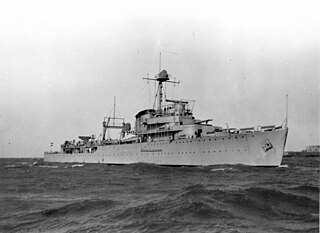
The Tromp class was a class of ships of the Royal Netherlands Navy. The hull shape was also known as the Argonaut 600. They were designed as "flotilla leaders" and their intended role was to be the backbone of a squadron of modern destroyers that was planned at the same time. The ships were ordered in 1935; Tromp was launched in 1937, and her sister ship Jacob van Heemskerck in 1939. Often referred to as 'light cruisers', they were significantly smaller and less capable than most light cruisers of the era.
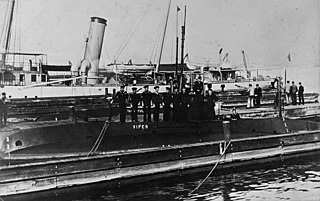
USS B-1 (SS-10) was the lead ship of her class of submarines built for the United States Navy in the first decade of the 20th century.

USS B-3 (SS-12) was one of three B-class submarines built for the United States Navy in the first decade of the 20th century.

USS Stewart (DD-224) was a Clemson-class destroyer in the United States Navy during World War II. She was the second ship named for Rear Admiral Charles Stewart. Scuttled in port at Surabaya, Java, she was later raised by the Japanese and commissioned as Patrol Boat No. 102. She came back under American control in 1945 after the occupation of Japan.

The Insect-class gunboats were a class of small but well-armed Royal Navy ships designed for use in shallow rivers or inshore. They were intended for use on the Danube against Austria-Hungary. The first four ships—Gnat, Mantis, Moth and Tarantula—were first employed during the Mesopotamian Campaign of the First World War on the Euphrates and Tigris rivers.

HMS Gnat was a Royal Navy Insect-class gunboat. She was built by Lobnitz and launched in 1915. Gnat saw service during the First World War as part of a flotilla operating on the Tigris and Euphrates rivers. After the war, the vessel was transferred to China, where in 1927, Gnat took part in the Nanking Incident. Gnat began the Second World War still in China, but was towed to the Mediterranean Sea in 1940. There, the gunboat took part in an assault on Tobruk before being torpedoed by a German submarine. Though Gnat did not sink, and was beached at Alexandria, Egypt where the vessel was used as an anti-aircraft platform. The vessel was declared a constructive total loss and scrapped in 1945.

HMSCricket was a Royal Navy Insect-class gunboat. She was built by Barclay Curle and launched on 17 December 1915.

USS Elcano (PG-38) was a gunboat that the United States Navy captured from the Spanish Navy during the Spanish–American War. She was officially commissioned in the U.S. Navy in 1902. She served for many years in the Yangtze Patrol where she saw action against pirates and warlords. She served until decommissioning in 1928, when she was sunk for target practice.

A floating battery is a kind of armed watercraft, often improvised or experimental, which carries heavy armament but has few other qualities as a warship.
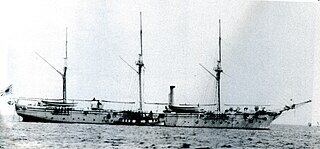
Amagi was a screw sloop in the early Imperial Japanese Navy, and was the third vessel built by the Yokosuka Naval Arsenal after its acquisition by the Meiji government. When built, Amagi was the largest warship yet produced domestically in Japan. Amagi was named after the Mount Amagi, in Shizuoka Prefecture, Japan.
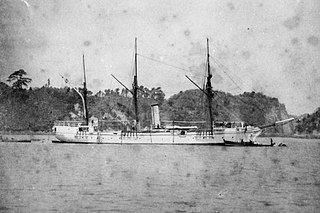
Banjō was a steam gunboat, serving in the early Imperial Japanese Navy. The ship was named after a mountain in Shizuoka prefecture.

HMS Tarantula was an Insect-class gunboat of the Royal Navy. Launched in 1915, the gunboat saw service in both the First and Second World Wars. Tarantula served with the Tigris flotilla in 1916, retaking a former British gunboat that had previously been captured by the Ottoman Empire. After the First World War, Tarantula was towed to China, joining the China Station, eventually ending up at Trincomalee, Ceylon during the Second World War. After the end of the war, the vessel was sunk as a gunnery target in the Bay of Bengal in 1946.
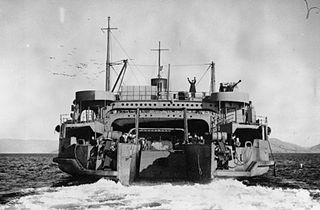
TSS Train Ferry No. 1 was a roll on roll off freight vessel built for the British War Office in 1917 to transport rail freight to Europe during the First World War. After the war, it was used for civilian purposes until the Second World War. During the war it was converted to carry and launch landing craft

TSS Train Ferry No. 3 was a roll on/roll off freight vessel built for the British War Office in 1917.

Turquoise was one of six Émeraude-class submarines built for the French Navy in the first decade of the 20th century.

The Battle of Amara, also known as the Second Battle of Qurna, was a military engagement between the forces of the British and Ottoman Empires during the Mesopotamian Campaign of World War I. The battle took place in the flooded marshes and islands along the Tigris river between the towns of Qurna and Amara and resulted in the British capture of Amara and rout of Ottoman forces in the area.

Mukaddeme-i Hayir was the second of two Feth-i Bülend-class ironclads built for the Ottoman Navy in the 1860s. The Ottoman Navy ordered her from the Imperial Arsenal in Constantinople, and she was laid down in 1870, launched in 1872, and commissioned in 1874. She was armed with four 229 mm (9 in) guns, was powered by a single-screw compound steam engine with a top speed of 12 knots. The ship saw action during the Russo-Turkish War of 1877–1878, but was laid up from 1878 to 1897. At the start of the Greco-Turkish War in 1897, the Ottoman Navy mobilized Mukaddeme-I Hayir and the rest of the ironclad fleet but found almost all of the ships to be in unusable condition. Mukaddeme-i Hayir was disarmed the following year and converted into a stationary training ship in 1911. After the outbreak of World War I in 1914, she became a barracks ship, and served in this capacity until 1923, when she was broken up.

Hifz-ur Rahman was the second of two Lütf-ü Celil-class ironclads built for the Ottoman Navy in the late 1860s. Originally ordered by the Khedivate of Egypt, an autonomous vassal state of the Ottoman Empire, the central Ottoman government forced Egypt to surrender Hifz-ur Rahman while she was still under construction at the French Forges et Chantiers de la Gironde shipyard. The vessel was a turret ship, armed with two 229 mm (9 in) Armstrong guns and two 178 mm (7 in) Armstrong guns, both pairs in revolving gun turrets.




















